
Tactics for Maintaining Mental Fitness During The COVID-19 Pandemic
Intentionally Maintaining Mental Health
Dr. Howatt, President of Howatt HR Consulting, believes being in isolation for 2 weeks will greatly impact our mental health. He says, “we are like batteries, and like batteries we can be anywhere from charged to empty on a daily basis.”
Personal and situational stressors can drain your battery such as stress, burnout, anxiety, harassment, chronic issues, gossip, workload, distrust, depression, injuries, and incidents.
You need to intentionally recharge your battery by prioritizing sleep, being active, eating fruits and vegetables and finding a connection rather than self-medicating.
If you have been following the NSFA on social media you can see we are trying to stay connected using zoom and Snapchat. Today we had a coffee break for 15 min over zoom just to catch up on what is going on with everyone. We are going to continue this on a daily basis.
Find creative ways to stay connected and charge your battery.
If you feel you are struggling with anxiety and depression as well as the inability to charge your battery, there is an anonymous peer support group online called The Big White Wall. Visit bigwhitewall.com. I screen shot is below giving a few details of how they offer support.

Alternatively, another source to reach out to is the Farm Family Support Center at 1-844-880-9142 it is confidential and immediate support is available 24/7/365.
Gratitude
Last week I attended a Mental Health Seminar on Tactics for Maintaining Mental Fitness During the COVID-19 Pandemic webinar by Dr Bill Howatt of Howatt HR. The response to the seminar was so overwhelming that Dr. Howatt is now leading a seminar each week while we maintain self-isolation.
In the previous webinar, Dr. Howatt mentioned we need to intentionally charge our batteries especially during this time of isolation as it can drain our batteries quickly. He mentioned making sure we prioritize sleep, be active, eat fruits and vegetables and find a connection as four ways to charge our batteries. This week, he focused on maintaining a sense of gratitude.
Gratitude is the intention of being grateful and showing appreciation; acknowledging what is good in our lives.
How do you incorporate gratitude into your day?
- Do you express it in a journal, write it on a post-it note and put it on your fridge?
- Do you have a gratitude object like a picture or a stress ball?
- Do you thank people in person or if at a distance, thank them mentally?
- Do you acknowledge others?
He reminds us to be sure to write down our Mental Fitness Plan as what is written, gets done; therefore, intentionally charging our battery. Keith Harrell, life coach and motivational speaker, of Harrell Performance Systems says:
“Write down what you want to do and for what purpose. Make a plan to achieve it – and then put that plan into action!”
Making the Social Connection
Sitting in on the Tactics for Maintaining Mental Fitness During the COVID-19 Pandemic webinar with Dr Bill Howatt of Howatt HR this week we explored how to make a social connection while being in self-isolation, working from home, and observing social distancing rules.
A social connection is a basic psychological need and we are auto-programmed to social thinking. It is incorporated into our life satisfaction and a central element to human evolution. Having a lack of connection for some can be the same as having physical pain sensations.
Dr. Howatt says improving your social connection can result in:
• Improved Immune System Function
• Decreased Chronic Disease
• Decreased Inflammation
• 50% increase in Longevity
• Improved Sleep
• Higher Self-Esteem.
We need to prioritize making a social connection and we can do it in the following ways:
• Taking the time to listen to others
• Set up video chat time
• Use video work sessions
• Set up regular check-ins
• Ask about life outside of work
• Acknowledge successes and challenges
A valuable connection can be made by doing something as simple as saying hello and smiling at someone when you are out for a walk or waving to someone as they drive by the farm yard. These tools are also ways to charging your battery!
Take the Mental Fitness Index survey. See if you are charging your battery. I took the survey and found there were many really good questions in relation to mental well being that I hadn’t thought about before and found it valuable to go through the exercise. You may surprise yourself.
Understanding Stress
In the last 4 weeks, Dr Bill Howatt of Howatt HR has been helping us navigate through self-isolation by providing micro skills on how to charge our battery in the name of maintaining good mental health during this difficult time.
Creating a Mental Fitness Plan and writing it down is key in charging our battery in combination with the micro skills learned. So far, we have learned to have an attitude of gratitude and the importance of making a social connection. This week, we understand the impacts of stress during such a difficult period in our lives.
As you know, there is good stress (Eustress) in which there needs to be a balance to keep us motivated in the things we do every day.
There is also bad stress (Distress). The balance of the frequency, intensity, and duration of this stress can predict our mental health risk. This is made up of the difference between what you want and what you have. If you are on the high end of distress you may relate to the following:
- Excessive worrying
- Increased emotional response
- Memory loss
- Feeling lonely
- Loss of purpose
- Increased sensitivity to stimulus
- Increased procrastination
- Increase physiological response
Some of us may cope with distress in negative ways such as drug and alcohol use, isolating ourselves, the use of food, or working too much.
Finding positive ways to cope with distress is important. Some healthy habits in dealing with distress may include:
- Having a support network
- Personal and Professional
- Maintaining social connection
- Problem solving
- Attitude of gratitude
- Social connection
- Exercise
- Gardening
- Pets
- Reading or Music
If you have a habit of using a negative coping mechanism, it isn’t as simple as removing that behaviour. The old behaviour needs to be replaced with a positive coping mechanism or behaviour. For example, if you go to a bag of potato chips or a glass of wine when you are stressed, you can’t just stop going to the potato chips or having the glass of wine, you need to be able to go to something else other than the potato chips or wine.
You will need to replace the eating or drinking habit with something else like exercise. Go for a 20-minute walk. If eating is what is preferred, substitute the potato chips for fruits or vegetables. Find something that will work for you. This will help the new behaviour become habit and in turn a positive method of coping with stress.
If you haven’t done so already, take the Mental Fitness Index survey. Click here to see if you are charging your battery. You will learn where you stand in regards to your own mental fitness and this may influence your Mental Fitness Plan.
Insulating for Anxiety
In Nova Scotia, we may be feeling anxious with imposed restrictions to prevent the spread of COVID-19 and after last weekends tragic and senseless events the feeling of anxiety may have heightened.
With heightened anxiety, it can be more difficult to recharge your battery. Dr. Bill Howatt of Howatt HR mentioned changes to your mental fitness plan to accommodate for the additional drain on your battery is warranted. Perhaps increase family check in frequency, additional moments of gratitude throughout the day, or allowing more time for yourself.
Dr. Howatt says anxiety is when our conscious and unconscious move into a hyperarousal state. He says this happens as our minds have 30-45 thoughts per minute, 40,000 – 60,000 thoughts per day and the majority of these thoughts happen unconsciously.
We are meant to have a certain level of anxiety as this keeps us alert and allows us to react quickly when necessary. For some people this can actually make them feel powerless and out of control when the alarm doesn’t turn off.
When you get caught in an anxious loop you may have:
- Difficulty sleeping
- Increased risk for addiction
- Questioning values
- Increased errors
- Increased hopelessness
- Loneliness
- Weight loss
How do you stop the anxious loop? Try any one of or a combination of the following:
- Deep Breathing
- Progressive Relation
- Count your breaths
- Mindfulness
- Meditation
Once you stop the anxious loop, explore why the anxious loop began. Methods to do this include:
- Note how you were feeling and give those feelings a name – identify them!
- What were your thoughts at the time?
- Ask what else could the thoughts mean?
- Ask yourself four or five times the meaning of your thoughts and you will find you exhaust the negative and move towards positive meanings.
- Use your resources
- Farm Family Support Center (1-844-880-9142)
- Online resources such as the “The Big White Wall”
- Your social network or a trusted friend
- Medical Professionals
Additional Resources:
A few additional resources that may be of benefit in insulating for anxiety include an Anxiety Quick Survey, using personal coaching techniques such as learning to think positively, and breathing relaxation exercises.
Survey
Take the Anxiety Quick Survey online to assess your anxiety risk level. The levels range form non-issue, to low, moderate, and potential serious concern. Which category do you fall under? What actions should you take?
Positive Thinking
Reference the following e-book called My Personal Success Coach: A Guide to Personal Wellness by William A. Howatt, Ph.D. for learning techniques on learning to think positively see Chapter 4 of the e-book.
Breathing Relaxation Exercises
Also, in the e-book look at page 197 to discover some breathing relaxation exercises to break the anxiety loop.
Social Contagion
As I write this article, my senses are confused, and my battery is draining a little bit more quickly with heavy wet snow falling after such a gorgeous weekend of sun and warm temperatures. Even a change in weather can impact how we are feeling and our feelings can then affect others. This is called social contagion.
Dr Bill Howatt of Howatt HR, says a person or even a group of people can influence our emotions and affect our behavior. This transfer of emotion can happen consciously or unconsciously. This often occurs as a result of our mirror neurons and happens as part of our survival instincts.
Emotions can be transferred from our partners, leaders, friends, family, media, the people around us and co-workers. These emotions can be transferred through social media posts, gestures, smells, word choices, facial expressions, voice tones, and our rate of speech.
Emotional contagion can have a negative impact on our health such as:
- the increase risk for heart disease,
- increased stress levels,
- increased anger,
- increased risk of depression and anxiety,
- increased isolation,
- increased risk of respectful workplace issues, and
- increased fear.
Emotional contagion can also have a positive impact on our health and well-being such as:
- being more cooperative,
- increased perceived competency,
- increased creativity,
- increased energy,
- increased happiness,
- lower levels of stress, and
- increased performance.
We can technically see ourselves in others based on the emotions we project.
- What do you see?
- How do you show up for work on the farm?
- What is life like at home?
- Who do you think is the biggest influence in your life circle?
- Who in your life circle has the biggest impact on your emotions?
These thought-provoking questions, may lead to an update of your Mental Fitness Plan.
Think about what you can do to project more positive emotions unto others?
Can this help everyone charge their batteries?
Journal 45 – A New Beginning
In the post, Social Contagion, I left with some thought provoking questions to help update your mental fitness plan to project more positive emotions.
The questions were:
- What do you see?
- How do you show up for work on the farm?
- What is life like at home?
- Who do you think is the biggest influence in your life circle?
- Who in your life circle has the biggest impact on your emotions?
Prime Minister Trudeau said in a press conference recently, once restrictions are lifted, there will be a new normal, and things won’t be like they were before the pandemic. That was cause for reflection on work-life balance and goals moving forward. Life on the farm and how you farm moving forward may look quite different too.
Perhaps it is time to evaluate current goals and set new ones. Re work the plan and include mental fitness in part with physical fitness and social connection.
If you need a boost in getting started, I recommend reading Journal-45: A 45-Day Program to Create a New Beginning. It is about 114 pages but includes journaling pages and activity pages for thought and exploration.
This journal is an excellent tool to learn your work-life balance and how to get more positivity in your everyday life. Journal 45 includes a self-assessment, provides a process to set goals, show you how to journal for the next 45 days to monitor your growth, and have you doing a few different activities to enhance your work-life balance.
For me, if it isn’t written, it doesn’t get done. This is a great exercise to ensure I execute my plan and stick to my goals. Also, journaling through the next 45-days puts what I have written on paper into practice and then it becomes a habit. So far, there hasn’t been a lot of writing, just thought and reflection.
This well-laid out easy to read e-book will get you on your way to a new beginning. Feel free to share your goals and plans with us or others, they may jump start others into setting their own.
There is no time like the present to affect change.
Coping with Grief and Regret
For the last 6 weeks, Farm Safety Nova Scotia has been following Dr Bill Howatt of Howatt HR in weekly webinars on mental fitness. Each week, he has focused on a micro skill to help maintain mental fitness during this pandemic. Micro skills learned each week have included Tactics for Maintaining Mental Fitness, Gratitude, Social Connection, Understanding Stress, Insulating for Anxiety, and Social Contagion. If you would like to view these webinars in full visit maintainingmentalfitness.com or for summaries of the webinars with links to resources go to the Farm Safety Nova Scotia Website.
This week during Dr Howatt’s webinar, we learned about coping with grief and regret. I have always associated grief with a loss of a person, but I learned this week we can feel grief when experiences or abilities are removed from our lives too. Understanding the COVID-19 pandemic has resulted in immediate changes and also may result in long lasting changes, can cause us to grieve for what is lost. In a time of change, Journal 45 may be a great tool to explore a new beginning.
Some of the losses experienced in this pandemic may include a devastating loss of a loved one, social interaction, sense of safety, and community participation.
Grief is a normal response to such losses. It is a process that cannot be rushed and it is not linear. There may be stages of grief but each stage can happen at any given time or even be repeated. The stages of grief may include denial, isolation, anger, bargaining, depression, and acceptance.
Signs of grief can vary to include confusion, disbelief, sense of presence, preoccupation, upset stomach, breathlessness, tight chest, and muscle pain.
It is key to identify why you are grieving.
- Name what you are missing.
- Focus on the now.
- Identify what you can control.
- Exercise self-compassion.
Do not belittle your feelings and understand that it is ok to be upset.
To help with grief, allow time to grieve and get help.
- You can do this anonymously through grief cafes online.
- Call the Farm Family Support Center (1-844-880-9142 or https://www.workhealthlife.com/).
- Ask someone you trust for help.
- Show others kindness, love, care and compassion.
- Find time for Joy.
Supporting Others
Before you can support others consider the following:
- Is your battery effectively charged?
- Are you in a space of understanding, empathy and acceptance?
Dr Bill Howatt of Howatt HR says that we may be required to help others at some point in our life and it can range from helping with chores on the farm when labour is tight to being there when someone is experiencing a difficult time.
If you are looking for support, it is important to name what you need as other people are bad at predicting or guessing what we actually need. Be mindful of what you may need from other people.
When we provide support to others, we want to resist the urge in telling people what they need. Providing support has a bigger impact on our brain’s stress response than receiving support.
There are various types of support.
- Emotional Support gives us the feeling we are being cared for by others.
- Esteem Support is developing a sense of competence.
- Network Support allows us to feel like we belong to a group.
- Tangible Support is helping someone through a crisis.
- Information Support is providing advice and guidance.
Know your boundaries when providing support. Do not try to diagnose or be a health professional and most importantly be aware of compassion fatigue as it inhibits our ability to have empathy for others. Offer the person to call the Farm Family Support Center (1-844-880-9142 or https://www.workhealthlife.com/) if you feel you may not be in the place to support others as they need or if they need professional support.
Positive impacts on your health and well-being when you feel supported:
- Decrease in chronic disease
- Increase in reward activation
- Increased in mental fitness
- Increased happiness
- Increased sense of purpose
- Lower levels of stress
- Increased quality of life
- Increase in pay it forward
When providing support, be sure to listen to those around you, remove fear, acknowledge others in public, and conduct regular structured check-ins.
Reflections of the Day:
- What is the way you most commonly support people?
- What is the way you most commonly like to receive support?
Feeling Overwhelmed
A lot has changed since the COVID-19 pandemic has taken hold of our lifestyles. It has created a new normal for many of us. There has been a significant amount of change to our daily lives such as new social protocols, no self-care, increased drug and alcohol use, financial strain, labour shortages, online meetings and gatherings, restricted recreational activity, physical isolation, and potentially concerns about health if you have experienced the virus first hand or taken of care of someone who has.
The removal of aspects of our life that we have become accustom to can put extra strain and drain on our batteries and result in an increase in personal and societal tensions.
With all of this change we can start to feel overwhelmed. This can happen when we have too many responsibilities with not enough time to do everything. Small things can become earth-shattering and feel impossible to do and have the feeling as though we are in a pressure cooker.
If others are not aware and you don’t communicate where you are at, it can have significant impacts on our life such as mental health issues, decrease engagement and productivity, addiction risks, increase suicide, loss of purpose, mental distress, cause chronic disease, breakdown of relationships and an increase in anger levels.
Recognizing the signs that someone is feeling overwhelmed is important. What people do when they feel overwhelmed may include:
- Starting sentences with “I can’t…”
- They look scared. Scared of failing and the consequence for failing.
- Pushing people away or compartmentalize things.
- Start apologizing a lot because they feel as though they are letting people down.
A few micro skills for working with your thoughts and feelings of being overwhelmed:
- Remove one thing that you can do later, prioritize for another time or not do it at all.
- Normalize anxious feelings by letting them take their course.
- Stop multi-tasking. It is not doing two things at once, but rather switching your focus from one thing to the next. You don’t have total focus on one thing when you are multitasking.
- Forget perfection. Getting it done to the point it meets the needs is sometimes good enough rather than over engineering something. It is good you care but at what cost is it affecting your mental health.
- Delegate when you can.
- Set Boundaries. Say no when you can and give a reason for the “no.” You have the right to push back.
- Challenge assumptions. Don’t assume that things need to be done but ask if it needs to be done.
- Ask for help!
Reflection
- What is the area of your life that has you feeling overwhelmed right now?
- What is one thing you can do to address your concerns?
Dr Bill Howatt from Howatt HR compares our mental health to our physical health. He says you diet and exercise to prevent obesity, diabetes or heart issue. Why not take preventative measures to for your mind as well.
Suicide Ideation
Dr Bill Howatt of Howatt HR introduced a sensitive but important topic this week, and one that needs to be talked about more. Dr. Howatt says suicide is something that is a part of everyday life for many of us, and if you are having thoughts know you are not alone and there are tools available for you.
According to the National Survey of Farm Mental Health and Wellness of 2016, 1,100 Canadian producers participated in the survey. 45% described having high levels of stress, 58% stated having some level of anxiety, 35% had some level of depression, many reporting burnout, emotional exhaustion and high levels of cynicism. Surprisingly those who suffer had low help seeking behaviours.
Common Myths about suicide:
- Myth 1: Discussing suicide will cause the person to do it.
- Reality: Discussing it will likely provide a sense of relief and a desire to buy time to regain control.
- Myth 2: People who threaten suicide don’t do it.
- Reality: A large percentage of those who threaten suicide, do it.
- Myth 3: Suicide is an irrational thought.
- Reality: Nearly all suicides/attempts make perfect sense to the person.
- Myth 4: People who die by suicide are insane.
- Reality: Only a small percentage are psychotic or crazy. Most appear to be normal people with severe depression, are lonely, and feel hopeless.
- Myth 5: Once suicidal, always suicidal.
- Reality: While most people contemplate suicide at some time in their life, most recover from the immediate threat and live long, productive lives, free form the threat of harm.
Those who are feeling hopeless feel as though they have nothing. With no hope, there is low energy, a feeling of being stuck and that there is no way out but a desire to be rescued. For when you get overwhelmed, feel hopeless, stuck and do not believe life is worth living, there is help. Even though you may not know what to do, it doesn’t mean there isn’t an answer. Sometimes when we get caught in our brains, we lose out ability to problem solve. Dr. Bill Howatt had a great analogy for when this happens. If you compare your thoughts to your tractor, if the tractor doesn’t turn over, it doesn’t mean it can’t be fixed. Just because you may not know how to repair the tractor doesn’t mean you get rid of it and buy a new tractor. You find a mechanic who can help fix it. Just like with your thoughts, you can find a trained person to help you navigate through your thoughts.
5 Micro-skills that can help work through your thoughts include knowing when to get help, identifying the triggers, build up a community of support, be active, and relax.
Having awareness of those who may have suicidal thoughts can help in early detection of yourself and others.
Watch for overt and/or covert behaviours. Overt or open behaviours include someone talking openly about suicide, “I’m going to kill myself;” “I wish I were dead;” and “I wish I hadn’t been born.” Covert or not easily seen behaviours include acting in a peculiar way, “It doesn’t matter…I am not going to be around much longer;” talks about how hopeless things are; and saying good-by to people in an odd way like if they were never going to see them again.
Additional signs of suicide ideation may include:
- Significant sleep difficulty
- Increasing drug or alcohol use
- Displaying increased irrational behaviour
- Appears to be down & increasingly depressed.
- Recent trauma or life crisis.
- Engaging in more self-harmful behaviours
- Loss of interest in hobbies
- Sudden calmness after a long period of depression or anxiety
- Suddenly starts to give away personal items
- Out of nowhere starts putting affairs in order
- Creates or updates their will
- Begins to withdraw from usual activities
- Has experienced the recent death of a friend or relative
- Appears to be increasingly pre-occupied with death
- Previous attempts of suicide
- Drop in performance.
Anyone who threatens to commit suicide must be taken as a real threat. Don’t be influenced by group think (eg. Don’t worry about Jack, he’s crying out for attention). Understand that a threat of suicide is a gift, as it provides an opportunity to get the person the help they need. Not all people show typical signs of suicide. Even the most prepared crisis responder can be totally surprised and never notice any typical clues or risk factors.
If you feel you are struggling with the feeling of being anxious, depressed, or hopeless, reach out to the Farm Family Support Center at 1-844-880-9142 it is confidential and immediate support is available 24/7/365. Alternatively, the Mental Health Crisis line is available 24/7/365 by calling 1-888-429-8167.
Insulating for Irritability
 Dr Bill Howatt from Howatt HR had some great insight on insulating for irritability this week. He says irritability is a common emotion and there are many factors that cause or contribute to a person’s irritability. For example, changes in hormone levels, blood sugar levels, lack of sleep, financial challenges, emotional strain, and life demands. Probably, all of us have experienced one, some, if not all, of these causes during the COVID-19 pandemic. For many farms, the financial and labour challenges alone with government-imposed restrictions have played a large role on how the farm will operate for the next 12-18 months at least, if not longer.
Dr Bill Howatt from Howatt HR had some great insight on insulating for irritability this week. He says irritability is a common emotion and there are many factors that cause or contribute to a person’s irritability. For example, changes in hormone levels, blood sugar levels, lack of sleep, financial challenges, emotional strain, and life demands. Probably, all of us have experienced one, some, if not all, of these causes during the COVID-19 pandemic. For many farms, the financial and labour challenges alone with government-imposed restrictions have played a large role on how the farm will operate for the next 12-18 months at least, if not longer.
These contributing factors for irritability can influence our physiology, environment, and level of stress. All of these factors can create an inability to “shrug-off” the little things which results in irritability.
Dr Bill Howatt mentioned there is a difference between anger and irritability. Anger is an emotion that is usually triggered by a specific person or event where irritability is usually described as a mood but is not related to a particular event.
Often when we feel irritable, we don’t know what is going on. It feels like stress and irritability can make a situation worse if an irritable person acts on their emotions instead of walking away and regrouping.
An increase in irritability can put strain in our community and on the farm. With irritability comes a decrease in compassion, empathy, and social awareness. Often people will feel on edge, grumpy, cranky, and sour. This can result in being more aggressive than usual or short with people around us.
Signs we may becoming irritable:
- Excessive sweating
- Trembling
- Fast heartbeat
- Headaches
- Feeling dizzy or lightheaded
- Feeling like nothing in life is working
- Dependency
- More frequent outbursts
If the frequency, duration and intensity of being irritable begins to increase, it may be a sign of an underlying mental health issue.
Four micro-skills for preventing and moving through irritability include reducing caffeine and alcohol intake, acknowledging the source, compassion, and being able to burn nervous energy.
For reflection:
- What’s your default behaviour when you become irritable?
- How do you catch yourself?
Engaging Your Environment
 Mental health involves our environment, genetics and our actions to include the physical, mental and social components. Dr. Bill Howatt from Howatt HR states, genetics makes up about 50% of our mental health equation.
Mental health involves our environment, genetics and our actions to include the physical, mental and social components. Dr. Bill Howatt from Howatt HR states, genetics makes up about 50% of our mental health equation.
Focusing on the environmental component of mental health, our mental health can be influenced by many different factors such as life experiences, the workplace, and our social economic conditions. These factors can be more important than health care or lifestyle choices on mental health.
Our job and financial health are the top determinants to putting our mental health at risk. During the COVID-19 pandemic, there has been great uncertainty with our jobs, finding workers to work on farm, and in turn questioning the financial health of the farm due to lower yields or crops left in the field as well as the cost of supplies and the ability to sell product.
The three most impactful social determinants are freedom, social inclusions, and access to economic resources. Different people and communities are impacted by all determinants in various ways which can lead to health inequities. On the farm, policies, support options, social connections as well as training and education can influence your mental health.
Four micro skills to consider for engaging with your environment include life checkup, see something – say something, self-care basics, and knowing your community resources.
Life checkup refers to things like checking in on farm and equipment insurance, ensuring things are safe, life insurance, and making a last will in testament.
See something-say something involves speaking up or getting help when needed rather than suffering from the bystander effect.
Self-care involves regular medical checkups, knowing how to use the employee assistance program or Farm Family Support Center, and financial stability.
Know and use your community resources such as the Farm Family Support Center (1-844-880-9142 or workhealthlife.com) and the Mental Health Crisis Line (1-888-429-8167) as well as community groups, friends, and family.
How would you rate the following on a scale of 1 to 10?
- Psychological Safety
- Physical Safety
- Food Security
- Job Security
- Financial Security
- Housing Security
If a score of less than 7, where 7 is OK, is achieved in any one of the 6 categories, it indicates worry or becoming worried. Work out how to action the item to bring up the score to then be able to work on improving mental fitness.
Visit maintainingmentalfitness.com for more resources in tactics to maintaining mental fitness during COVID-19.
Mindful Hydration
Dr Bill Howatt of Howatt HR in the Tactics for Maintaining Mental Fitness during the COVID-19 Pandemic webinar series says mindful hydration is the act of being fully present and aware of the sensations while drinking water. It requires you to slow down and intentionally focus on each sip of water. It can be used multiple times throughout the day or in moments you need to pause.
Mindfulness is the ability to be fully present in the moment. You have an awareness of all of your senses through an open and supportive lens. It is paying attention to our thoughts without judgment with the intention of kindness.
Are you drinking enough water? Males need approximately 3 liters and females need about 2.5 liters of water per day. The amount is individually based on a person’s body weight and temperature, the amount of exercise, the physical environment and many demographic variables. If you are feeling thirsty, then you are already dehydrated.
A good way to measure and monitor hydration levels is through the color of your urine. The darker the urine the more dehydrated you are and the lighter the urine the more hydrated you are. Take a look at the scale below.

What is mindful hydration?
Mindful hydration is something that can be done in 90 seconds. Take 30 seconds to review the steps and prepare yourself. To mindfully drink water takes only 60 seconds. The goal is to start with One Moment per day, and add one mindful drinking moment to your day for 10 days until you get to Ten Moments per day.
Benefits of Hydration: Improved gut health, sleep quality, decreased stress, reduce risk of migraines, mood and cognitive functioning, increase blood flow, energy level, concentration, and lower levels of depression.
Benefits of Mindfulness: Sleep quality, decreased stress, reduce risk of migraines, mood and cognitive functioning, reduced risk of mental health issues, increased innovation, increased compassion, reduced physical pain, and increase in internal locus of control.
There are several mindfulness tools available. Look for tools supported by research. Find one that fits best for you, it may not necessarily be the one that shows up first in Google, and any one tool isn’t the golden bullet that solves all your problems but a micro skill to help you pause and regroup.
Let’s try the mindful hydration tool below to get you started:
- Create Intention

- Find a safe place without distraction and you are 100% safe. This shouldn’t be done while driving or while performing a hazardous task.
- Grab a bottle or glass of water (this is your “anchor”), sit and be comfortable.
- Clear your mind.
- Take a deep breath and exhale slowly emptying your lungs. Do this three times. For the last deep breath put your hand on your wat
er bottle or glass (your “anchor”).
- Clear your Mind
- After your third breath, look at the water. What do you see? Purity, clarity, calmness?
- If your focus shifts throughout the process that is ok, this takes a little practice.
- Continue to Practice
- Slowly bring the water to your mouth and take a mouthful.
- Focus on the water and the notice the space it fills in your mouth.
- Swallow the water slowly.
- Notice the slow, clear, peaceful water falling down your throat with each drink.
- Between each mouthful, take a deep breath and exhale.
- Focus on the water.
- When you mind jumps around, simply refocus on this simple activity and notice the water – nothing more.
For additional information, read Mindful Hydration Can Reduce Stress & Boost Productivity by Howatt HR Consulting.
Anchoring Your Why?
It is interesting to note, that the Farm Safety Nova Scotia Mind the G.A.P. FARM-FARM-FARM campaign aligns with Dr Bill Howatt’s process in readying ourselves for change and how that change may be anchored to become a habit. Dr Howatt from Howatt HR says we have two brain centers, the Administrator Brian and the Caveman Brain. The Administrator Brain involves our conscious decisions and actions while the Caveman Brain is built for survival, and may not always give us good advice. In Mind the G.A.P., we speak to the Fast Brain and the Slow Brain. The Fast Brain which is our reactive automatic thinking and the Slow Brain being our thoughtful reflective side. Fast Brain like Caveman Brain can result in frequent errors and Slow Brain like Administrator Brain when used, will result in fewer errors.
We need to engage the Slow Brain or Administrator Brain to affect change. This allows us to assess our readiness for change. Our readiness for change can be blocked into three categories: Red, Yellow and Green.
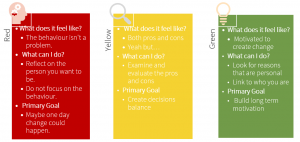
In order to anchor your motivation for change you need to be clear on your purpose. We work from the outside of “what” to the middle of “how” to the inside of “why”.
- “What” is quite easy to establish as it is the outcome you are looking for.
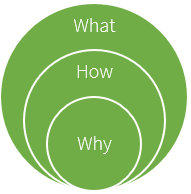
- “How” is a bit more challenging as you need to figure out what you are going to do and establish a process, plan or strategy to get it done.
- “Why” is the most difficult as it is hard to explain the purpose, cause or belief for change but once it is established, it can increase the likelihood of maintaining or “resetting” our motivation.
Long Term Motivation
There are two ways to anchor long term motivation. First by defining your personal values and second, by establishing goals.
Your personal values are things that are important to you and define who you are as a person. You can link your change to these values.
Steps to setting your personal values:
- Review a list of common values and write down the words that resonate with you
- Group like words together into larger categories (keep it to a maximum of 5 categories).
- Pick one word from the category that resonates the most with you.
- Pick one behaviour you are currently doing that demonstrates each value.
- Pick one behaviour you would like to do that aligns to your values.
- Keep yourself accountable.
- Provide a list of 10 values to three people
- Ask them to pick the 5 they feel best resembles you.
When establishing goals, ensure they are specific, measurable, attainable, relevant and timely (SMART).
Barriers in Motivation to Change
There are two main barriers that can decrease your motivation for change and interfere with the change itself, negative self-talk and the expectation to fail.
Negative Self-Talk

Expectation to Fail
When facing failure with a negative perception it can make the same goal seem less attainable, distort your perception, increase feelings of helplessness, performance anxiety, and create an unconscious “fear of failure” “It isn’t a question of if you will fall off the wagon, but how quickly can you get back on.”
How to Anchor Your Why?
Forming a new habit requires a trigger, motivation and reward to sustain overtime.
Success factors:
- Be clear what you will do.
- Ensure you have competencies.
- What is realistic for you.
- What supports are available to you.
- Make a social contract tell, others about your plan.
- Be mindful of your personal resources (time, money).
- Using small changes, and wins to create larger change.
- Journal/log process important keep a record. When it is written it will get done.
As we establish our new normal post COVID-19, what changes will you make? Why will you make the change? What personal values will you use to instill the change?
Visit maintainingmentalfitness.com to view the full webinar and available resources.
Prioritizing Sleep?
In this week’s webinar on Maintaining Mental Fitness During the COVID-19 Pandemic Dr Bill Howatt from Howatt HR talked about prioritizing sleep. This is a topic dear to me in two ways. The first, I prioritize sleep over all else and have done so for many years as I know I benefit from it a great deal. I am mocked by many for my stringent sleep schedule but this is something I will not compromise. The second, fatigue is one of the major risk factors for farming incidents and injuries. The Cultivating Your Way to Burnout webinars on June 9 or 11th, focused on fatigue at risk management as well as the Mind the G.A.P. FARM-FARM-FARM campaign outlines fatigue at risk management (FARM) as one of the three methods to improve safety on the farm.
Why is sleep so important?
- Sleep is one of the most vital processes for survival.
- Comprised of four stages of REM and NREM Cycles.
- The majority of people require 7-8 hours for optimal functioning.
- Research is showing less than 1% of the world’s population sleeps less than 5 hours of.
- However, research suggests that 1 in 3 people are not getting enough sleep.
- Lack of sleep is comparable to being intoxicated.
- 17 hours awake = 0.05 Blood Alcohol level
- 21 hours awake = 0.08 Blood Alcohol Level
What influences sleep?
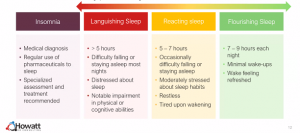
How can sleep impact me?
Sleep can impact brain function and overall quality of life.
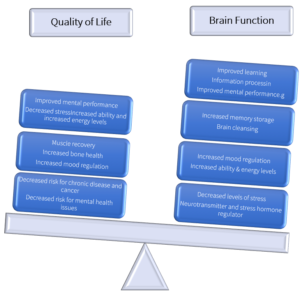
Here are four Micro-skills to help with your sleep hygiene:
- Limit caffeine and alcohol, especially before bed.
- Create a pre-bed routine.
- Disconnect from screens.
- Create a cozy but cool dark sleep space (15-18 degrees Celsius).
Watch your thoughts, beliefs, and emotions by writing down your thoughts, focus on your senses, practice deep breathing, and be patient and kind to yourself.
If you are concerned about your sleep, you are not alone. Many people struggle to get a good night’s sleep and have difficulty managing their sleep. See your doctor to rule out any physical health concerns that may be interfering with sleep and reach out for support. Ask your doctor if there is a local sleep assessment and treatment programs, they can connect you with. Most important, destigmatize treatment for sleep issues.
For more information or to watch the full webinar visit maintainingmentalfitness.com.
Fueling Up With Nutrition?
Another tool to add to our toolbox for Maintaining Mental Fitness during the COVID-19 pandemic is to ensure we are eating correctly which includes fueling ourselves with nutritious food. Dr. Bill Howatt from Howatt HR says the basics of nutrition is to monitor your day to day caloric intake and meal habits, identify the food you eat that helps in fueling your body to take on the day, and knowing nutrition is the biggest contributor to weight management – so watching caloric intake to maintain physical fitness.
What influences our food choices?
 The social determinants of health are the biggest factor influencing overall nutritional risk
The social determinants of health are the biggest factor influencing overall nutritional risk
Food Addiction is the number one addiction in Canada! Be aware of mindless eating. At this point, the focus is on your emotions not nutrition and when feeling stressed be aware of what you are eating.
When you started to need a PHD to eat well?
- The modern Fad Diet was introduced in the 1930’s.
- There have been over 100 know “fad diets” since.
- 1500 books classified as “fad diets” are published each year in the US.
- The diet industry is worth over $35 Billon each year in the US.
The basic rule of thumb, if a food or supplement is telling you it is healthy it is most likely not. Characteristics of a Fad Diets can include:
- Focuses on appearance
- Promoted by a celebrity
- Provides no health warning
- Feels complicated
- Based on testimonials not research
- Requires purchase of specific product
- Rapid weight loss
- Focus on one food
- Promoted as the secret
The areas of nutrition that will have the biggest impact on mental fitness include getting back to the basics by eating food with nutritional value to include fruits and vegetables as well as drinking water. Evaluate eating behaviours by controlling portion size and how fast you eat. Note the types of sugars consumed such as refined vs natural sugar and high fructose corn syrup. Consume nutrients that will improve performance such as macro-nutrients, pre/post biotics, and omega 3 and 6.
Four micro-skills to help with good nutritional habits are monitoring food habits, add one fruit or vegetable to each meal, be your own chef as you know what is going into your food, and don’t eat after 7pm. The after 7 pm rule is only if eating something not for nutrition. If you are having your final meal of the day from working a long day on farm, this is ok.
Four micro-skills to help if you are caught in an eating loop to feel better include limiting alcohol intake, leverage support groups, and buy only what you need.
Progressive Relaxation
If you were able to attend the Cultivating Your way to Burnout? webinar in June, it was interesting to find the audience perceived themselves to be quite fatigued when asked to rate themselves on a scale of 0-11. When they completed the fatigue calculator, it was surprising to note that the perceived fatigue was higher than the calculated fatigue.
As we learned, fatigue can be caused from lack of sleep but can also be caused by medical conditions or stress. With the onset of COVID-19, it is reasonable that even though we are getting 7-9 hours of sleep, that the stress related to this pandemic can cause us to feel more fatigued. Stress can create tension and physical pain in our bodies as well. Dr. Bill Howatt of Howatt HR says one of the ways we can release the tension and stress is through progressive relaxation. It was interesting to note that Dr. Howatt says that 29% of adults attribute neck and back pain to stress.
What is Progressive Relaxation?
It is a process where you intentionally relax specific muscles one at a time. This will release the stress that is being held in that particular area of your body. This will have an impact on your daily stress load, lessen anxiety and release muscle and joint tension and pain. This creates a state of mindfulness as you intentionally focus on the movement and allow your brain to get rid of the “noise.”
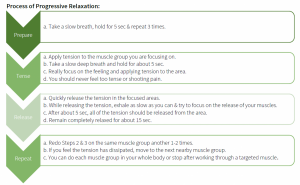
Below is a chart on how to focus on each muscle groups:
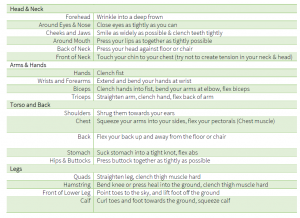
Progressive relaxation is another great tool to add to your toolbox for Tactics in Maintaining Mental Fitness in the COVID-19 Pandemic. Visit the Farm Safety Nova Scotia Website to view the tools highlighted this far or visit the Maintaining Mental Fitness website to view the full webinar series.
Flipping the Switch
The first in a series of posts, Tactics for Maintaining Mental Fitness during the COVID-19 Pandemic, Dr. Bill Howatt from Howatt HR said “we are like batteries, and like batteries we can be anywhere from charged to empty on a daily basis.”
As a result of the COVID-19 pandemic, some risk factors and challenges many workers were facing, have increased in intensity. This can decrease our battery charge and alter how we see the world. Below is a chart on the level of our battery charge and how that level affects our feelings, thinking, action at work, and health.

Flipping the switch can help charge your battery and provide another perspective on how you look at a person, a relationship, or a situation. By changing your perspective, you can change how you experience it. Flipping the switch when you are impacted by stress can change your physical and emotional response to stress. This is because our response has more to do with how we perceive stress than the actual event. Flipping the switch can minimize the time and intensity of a stressful event and increase our ability to recover.
To change your perspective:

What else can help you when trying to flip the switch?

To review the series of posts and micro-skills presented for tactics in maintaining mental fitness in this COVID-19 pandemic click here. You can read the posts in any order. Pick a topic that piques your interest and explore.
Coping with Isolation & Loneliness
On February 9th over the lunch hour, Jesse Adams joined us from Howatt HR to talk about coping with isolation and loneliness. Whether living in isolated rural locations of Nova Scotia or feeling the affects of the COVID-19 pandemic, can leave us with the feeling of isolation and loneliness.
Jesse reminded us that we are just like batteries, we can be anywhere from charged to empty on any given day. Personal and situational stressors can drain our battery such as stress, burnout, anxiety, weather, chronic issues, workload, distrust, depression, injuries, and incidents.
You need to intentionally recharge your battery by prioritizing sleep, being active, eating fruits and vegetables and finding a connection rather than self-medicating.
The COVID-19 pandemic has added additional stressors to our daily activities such as being restricted to our homes and farms, limited or no social gatherings, restricted access to regular services, COVID-19 protocols, and fear of becoming ill. These may also increase our feeling of isolation and loneliness.
We as human beings, need a social connection to feel as though we are cared for, valued and as a part of a group or community. We are programmed to focus on social thinking such as interpreting others thoughts and feelings. Where there is a lack of social connection, research has shown that we are more vulnerable to disease and death above and beyond traditional risk factors.
Isolation is the perceived barriers to making social connections such as technology, self-confidence, mental health, work, and personality.
Loneliness are feelings caused by perceived inadequacy of social connections.
If you are experiencing signs and symptoms of isolation and loneliness, perhaps the following tips may help cope with those feelings:
- Positive self-talk
- Be aware of how you show up
- Leverage support systems
- Be clear: loneliness is a feeling not a fact.
A few tips that may help others that are experiencing signs and symptoms of isolation and loneliness include:
- Make time to connect
- Practice humility
- Don’t assume
- Ask questions
Join us March 18th for another lunch hour micro-skill from 11:30am – 12:00pm, Navigating Crisis. To register e-mail info@farmsafetyns.ca or call 902-957-2785.
For additional micro-skills in Maintaining Mental Fitness, visit the Farm Safety Nova Scotia COVID-19 webpage
If you feel you are struggling with the feeling of isolation and loneliness, reach out to the Farm Family Support Center at 1-844-880-9142 it is confidential and immediate support is available 24/7/365.
Alternatively, the Mental Health Crisis line is available 24/7/365 by calling 1-888-429-8167.




